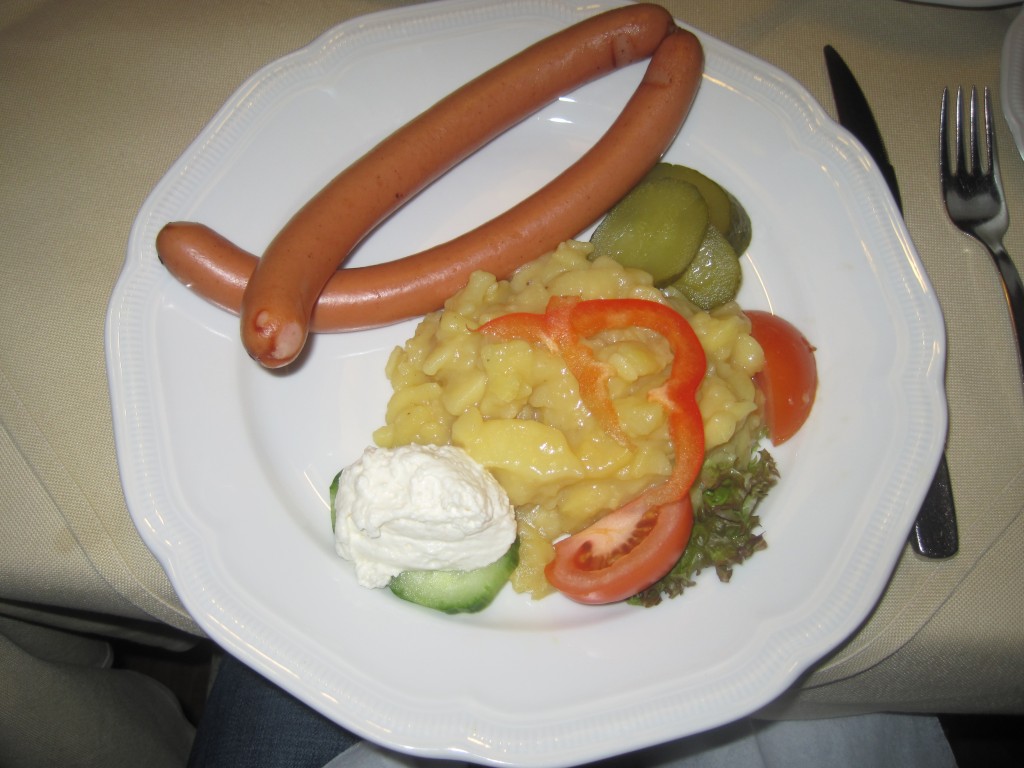I’ve Got the Hunger
Every night I toss and turn, and I can feel my soul yearning with a hunger I cannot presently fulfill. It has been two months since I’ve last satisfied this longing, and the serious void that has been left in my life has left me struggling to function as a human being. What is this yearning for you ask? What is my hunger? My soul longs for German cooking, of course.
In the past I thought that the Italians had the whole cuisine thing figured out, and they can certainly make a good case for having the best food in the world. I’ve found that Korean dishes, too, have their merits and could make a good case for the title. Others will stake out a particular region of China that has, bar none, the best food in the world. Yet others of an Iberian persuasion swear by Paella and Tapas, while still others praise the Argentineans’ dexterity with a cow, and even more point to the Indian sub-continent as the world’s culinary heart. Many settle on a burrito from Chipotle as the ultimate gastronomic experience. In Williamsburg especially there seems to be a consensus that there’s nothing better than the foods emblematic of good ol’ Southern cookin’; pit barbeque, sweet potato pie, grits, and sweet tea. And by my own admission, my fellow intern Kylee does make a mean banana pudding unlike anything I’ve ever tasted before.
However none of this food speaks to me, or rather my stomach, the way that German cuisine does. I didn’t grow up on German food, but I’ve certainly decided to adopt it as my own after a blissful 4 months abroad in Freiburg, Germany. When I tell people how good the food was, they look at me cross-eyed, like I just did the Guten Tag Hop Clop (http://www.youtube.com/watch?v=ylIHUWVef9Y), and I certainly think German cuisine gets a bad rep, or at the least is very underrated.
Fear not dear reader, for I will not let you fall into the misconception that the palate is foreign to the Germans. Here, in itemized form, is why German cuisine is, in my opinion, the best cuisine in the world.
1. Potatoes: I don’t know if it is something in the drinking water there, but it seems like every man, woman, and child in Germany just knows what to do with a potato. Pommes, or what we would call French fries, often take a back seat to a myriad variety of potato dishes. Kartoffelsalat or potato salad is sacred, and my flat mate made an incomparable batch. But Kartoffelpüree, mashed potatoes, and Salzkartoffeln, boiled potatoes, are equally as common. If you haven’t guessed by now, ‘Kartoffel’ means potato. German cuisine often calls for a Kartoffelgerichte, or side dish centered on potatoes, in nearly every regional specialty, and I never came across one I didn’t like.
2. Sausage: “So let me get this straight”, I asked the butcher at my local grocery store upon my return to the U.S., “you don’t make your own sausages here?” “No, but over in the refrigerated section, you’ll find some great stuff from Johnsonville”. Now you know why I started weeping to myself quietly in the middle of a crowded grocery store. No doubt Johnsonville makes some great stuff, but the meat counters in Germany are unparalleled, and the quality and variety of Würste is overwhelming. My favorite? Münchener Weißwurst, a white sausage from Munich flavored with parsley and onion, and often eaten for breakfast.
3. Maultaschen: A more regional specialty from Swabia, Maultaschen are dough pockets filled with vegetables or minced meat. German grocery stores carry a diverse variety, and once boiled in broth and served with (surprise) Kartoffelsalat, they make for a tasty yet quick and easy and traditional Swäbisch meal.
4. Spätzle: This is the German equivalent of Mac and Cheese. It consists of egg noodles, grilled onions, bacon, and lots of cheese. This is yet another dish that is easy to make and so very delicious. I easily hooked my parents on Spätzle when they came to visit, and it’s nowhere to be found in the U.S., so at least someone can share in my pain.
5. Flammkuchen: Flammkuchen is a specialty of the Elsass or Alsace region that has bounced back and forth between France and Germany. Flammkuchen, or tarte flambeé in French, is a flatbread with red onions, thin strips of ham, crème fraiche, and usually Gruyere cheese. It has a unique taste, and if you’re lucky you can find them stateside at Trader Joe’s.
6 . Bread: Bäckereien, or bakeries, were perhaps the most tempting part about living in Germany. Bread is an essential part of every meal, and Germans get quite creative when they put dough in the oven, and the results are overwhelmingly positive. My personal favorite was Sonnenblumenkernbrot, or bread with sunflower seeds baked in.
7. Veggies: Every day but Sunday in Freiburg there was a farmer’s market in the central square, and fresh, local veggies were the main attraction. You have to have something green with every meal, and local asparagus and broccoli were perfect complements to a hearty plate.
8. Beer: German beer is not good, it’s great, and probably deserves its own blog post from me. Paulaner Hefeweizen Dunkel, served at room temperature of course, is the best beer in the world in my humble opinion. Lucky for me, Williamsburg has a Bavarian beer garden that serves all of my favorite varieties, plus schnitzel, which is technically Austrian, but also delicious.
While many of the items listed above are heavy and hearty, the key is to eat in much smaller portions. All of these things will fill you up, but you would be wise to avoid overeating any of them, of course. And while you can find some of these specific things in the U.S., they are certainly not easy to find, and when I have found them, it’s just not the same. So I’m still going to toss and turn in my sleep, dreaming of sausages and potatoes, until I can make my way back to Germany.





No comments.
Comments are currently closed. Comments are closed on all posts older than one year, and for those in our archive.